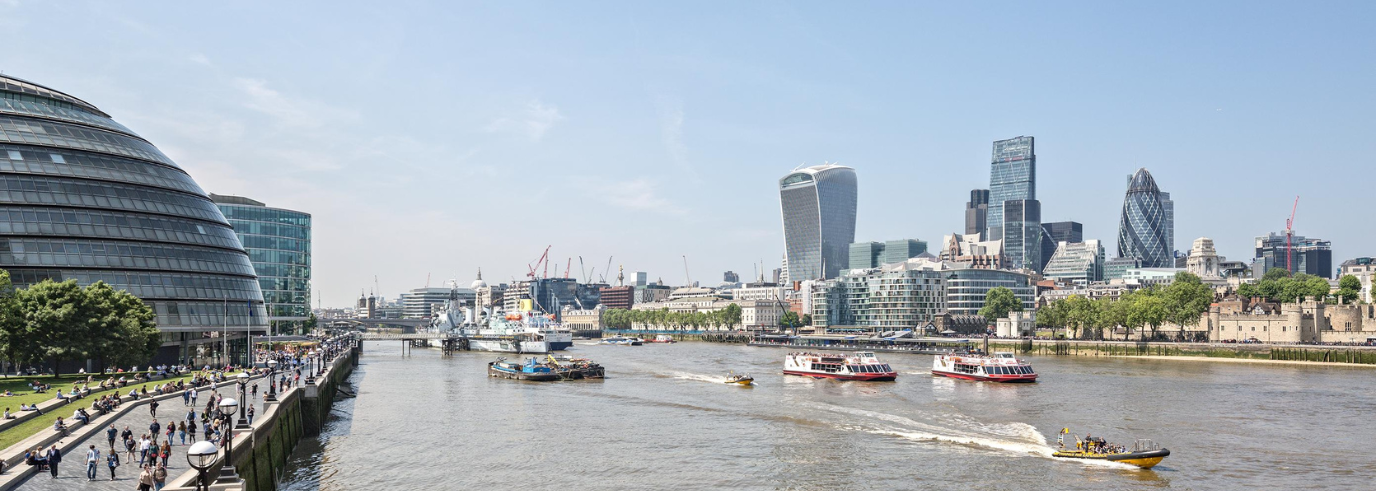
River runs through it
A lot of water has flowed under the Thames’ bridges since its days as an open sewer. We look back at the river’s long history and why it’s so popular with property hunters.
3 November, 2022
“Dirty old river, must you keep rolling, flowing into the night?” asked The Kinks a little unkindly, while admiring the sunset from Waterloo Bridge. Although the Thames can look brown – due to the muddy banks – it’s considered to be one of the world’s cleanest rivers. While the Thames in post-industrial Victorian London was virtually an open sewer, it’s made an impressive comeback; from being declared biologically dead in the 1950s to hosting 125 species of fish today. It’s also now a hotbed for in-demand properties with a view of those waters.
Progressing with the times
From gracing the EastEnders credits to Monet’s famous view of Westminster, the 210-mile long River Thames is indelibly stamped on our cultural consciousness. Its significance was cemented when the Romans developed the Port of London – Londinium – around 50AD, so that trading vessels could come into the safe river berths on the north bank and unload.
Centuries after the Romans packed up, the Saxons’ settlement of Lundenwic went on to become a major trading and ship building area for the Normans and Tudors. By 1576, London could boast that it was the world’s major trading port, and royal palaces at Windsor, Sheen, Hampton, Westminster, Bridewell, the Tower of London, and Greenwich were all sited on or close to the Thames, so that royal barges could ferry their regal passengers between them.
It was the Romans who first tackled the problem of getting large numbers of people – mainly soldiers – from north to south London, when they built the first bridge. Up until 1750, when Westminster Bridge was opened, London Bridge was the only crossing over the Thames, but when the Millennium Bridge opened in 2001, it took the total number to 35. These bridges are a vital part of the Capital’s infrastructure, offering a panorama of the city’s iconic views.
However, for centuries, it was quickest and most convenient to get across London by water and you could hire a wherry – a passenger rowing boat – at the many stairs leading down to the Thames. “These boats went along the river as well as across it, meaning that residents used to have a great knowledge of tides,” explains historian Peter Stone.
“Famous diarist and naval administrator Samuel Pepys used to whizz up and down, probably getting to places quicker than you could today if you were driving.” There were many road crossings over the river, but none east of London Bridge, adds Stone. “To carry goods from docks or factories on one side of the Thames to a location on the other involved a long and torturous journey through narrow streets and over the congested London Bridge. It was said that to carry a cargo of skins from Wapping to the other side of the river cost more than bringing them across the Atlantic from Hudson Bay.”
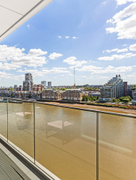
Anything close to London Bridge or Waterloo is very popular due to the links to Canary Wharf and the city for work.
Evolution of the docklands
New docks such as East India, Millwall and Royal Albert opened in the 18th century, followed by quays, wharfs and warehouses. But the Thames and its docks took a heavy beating during the Second World War and when these wharves closed down and residential areas fell into disrepair, thousands lost their jobs and squatters moved into empty warehouses. By the late 1960s, containerisation was having a big impact on dock use and container ships began carrying large amounts of cargo to Tilbury instead.
After more docks closed, the London Docklands Development Corporation kicked off regeneration in 1981, starting with the Thames Barrier in Woolwich. In that money-driven decade, financial, investment and insurance industries exploded, along with a plethora of houses and leisure facilities to service workers. The Docklands Light Railway and the Excel Centre followed, transforming the docks. During the 1990s, thanks to the new Thames Path, the old docklands had an easy walking route to the Square Mile, prompting disused buildings along it to be converted into apartments, shops, restaurants and nightclubs for riverside residents from the South Bank to London Bridge, and out to Richmond and Kingston.
Since the East End has had its overhaul, the south side of the Thames has been transformed from wharf wasteland into property hotspot, creating huge developments that now dominate the Thames skyline such as Greenwich Peninsula, South Quay Plaza, Royal Docks and Battersea Power Station.
“Anything close to London Bridge or Waterloo is very popular due to the links to Canary Wharf and the city for work,” says London Bridge lettings branch director Ben Rayner. “Also, anything near Borough Market or Bermondsey Street always gets a lot of interest due to the well-known and loved locations. Delving further into the postcode you’ve got a lovely pocket called Shad Thames that is next to Tower Bridge and my favourite street is Trinity Street in Borough – a quiet area full of Georgian houses surrounding an old church square.”
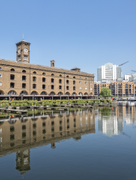
Anything close to London Bridge or Waterloo is very popular due to the links to Canary Wharf and the city for work.
Room with a view
Fulham is one of the Capital’s most sought after postcodes, but add in a direct view of the Thames and you’ll be paying an extra 10-15% compared to a similar property facing inland, perhaps just a street away. In fact, most Thames-side properties demand a premium. For example, anything in Shad Thames – near Tower Bridge – or along the river usually adds 10% onto the rent.
These homes near the Thames are always in high demand and with only so many waterfront sites, they’ll generally retain their value. With a proliferation of new developments, more homebuyers and renters are being given the chance to join this exclusive riverside club.
It means that someone looking for their slice of river life should get more choice in areas such as Canary Wharf with its plentiful apartment blocks than in the stretch between South Bank through to Shad Thames where residential properties are less numerous.
As with most developments, apartments usually command a premium for height, with the priciest often near the top, boasting the best and most exclusive views.
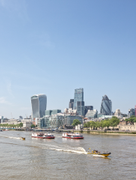
Feel the power
Known as Nine Elms, the area between Vauxhall and Battersea is the largest regeneration zone in London and includes the last remaining industrial stretch of the South Bank. A new town centre is springing up around the power station, adding 20,000 new homes to the 10,000 existing households where public walkways draw young professionals who make the most of the integrated café and restaurant culture.
Neighbouring Kennington is already a diverse area, full of pretty Georgian squares, a strong community spirit and green spaces. With the Northern Line extension from Kennington to Battersea Power Station and Nine Elms station, this area’s location and improved transport connections are making Nine Elms even more sought after.
From east to west
In east London, renovated warehouses sit surrounded by dockyards slapbang on the riverbank and new schemes on both the north and south banks are also quite literally a stone’s throw from the water’s edge. There are many other areas in which to find a riverside des-res including on the south-east stretch of the river, at the Rotherhithe Peninsula, which includes Rotherhithe, Canada Water and Surrey Quays, with its Victorian streets, pubs and 19th century warehouse conversions.
Over the water in Wapping, residents can kick back in some of the oldest pubs and smartest warehouse redevelopments, notably the grand Oliver’s Wharf. Stretching through the Isle of Dogs and into Canary Wharf, these ex-industrial docks are a popular postcode. While along the river in Greenwich, you’ll find elegant buildings and maritime history drawing tourists and students – it’s also a great place to call home with plenty of green spaces, riverside pubs and a popular market.
Families love the eye-catching houses, parks and good schools in south west London, in Barnes, Kingston upon Thames, Mortlake, Putney and Richmond. Barnes and Kingston are on particularly pretty stretches of the Thames, with riverside restaurants, bars and cafés providing a real village atmosphere.
Twickenham is known for its peaceful 1920s and 1930s roads, while in next-door Richmond, you’ll find smart Georgian and Victorian houses along Richmond Hill – and neighbours in the shape of deer herds at Richmond Park, London’s biggest enclosed space. Putney boasts Victorian terraces near the river, and is only a short commute into central London. It’s no less desirable over on the north bank of the river, where commuters and young families make the most of city living in Chelsea, Hammersmith, Chiswick and Fulham.
In Fulham and Chelsea, sales branch director Alistair Kidner reports: “The area known as Sands End is particularly popular with its beautiful period houses on quiet residential streets which are close to the river and are walking distance to the Kings Road.” Lettings branch director Gareth House adds that for renters, the areas that are most popular are anything within a 10-minute walk of Fulham Broadway Tube station, along with the newer developments down by the river such as Chelsea Creek and Imperial Wharf, which also has its own train station.
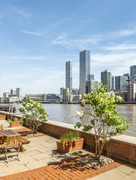
“The riverside developments especially Globe Wharf and New Caledonian Wharf ... are where tenants want to be.”
Greater reach
Within Hammersmith, Fulham Reach, Queen Caroline Estate and Rainville Road are all flagged up by the local KFH branch as some of the most sought after areas. Hammersmith sales branch director Robert Hayllar explains that Fulham Reach’s luxury development offers residents a superb concierge service, spa, cinema, gym, snooker room, wine tasting and virtual golf – all while overlooking the river.
On the Queen Caroline Estate, a collection of ex-local authority blocks offer buyers an affordable river home, he says. “Not all the blocks have river views, but those that do command a premium and are sought after.
While ex-local authority properties are not as desirable as a Victorian conversion per-se, this is often forgotten about when the river comes into view.” Rainville Road, backing directly onto the Thames, has a few mews houses as well as some spectacular properties, one of which is a new-build riverfacing freehold townhouse in Palace Wharf, a boutique gated development with direct river path access, on-site concierge and 24-hour security.
“There are also some very attractive mansion blocks around Hammersmith Bridge, which are highly sought after owing to their curb appeal and the fact these blocks are generally considered to be better built than a conversion flat,” adds Hayllar.
Seamus Stanbury, lettings assistant manager at the Canada Water office, explains that renters particularly appreciate anything directly outside the Canada Water station due to its location and the local amenities. “We also find that houses within a 10 to 15-minute walk from the station are very popular with families, attracting strong demand,” he says.
“The riverside developments especially Globe Wharf and New Caledonian Wharf, along with Marine Wharf and Greenland Place, are where tenants want to be.” Meanwhile, the perennially popular Chelsea, particularly Sloane Square and Kings Road, offer sophisticated shopping and nightlife, not far from the water. Where cargo ships and trade once defined the Thames, waterfront living has created prime areas of real estate along its banks, revitalising the Capital’s property market and status.
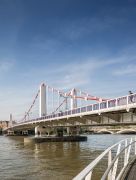
Looking for your own riverside property?
Our London property experts can help.